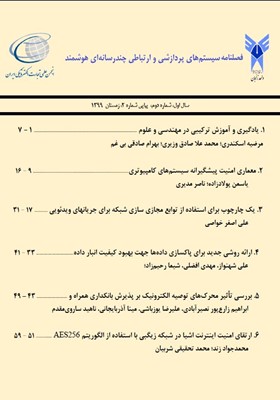معماری امنیت پیشگیرانه سیستمهای کامپیوتری
محورهای موضوعی : پردازش چند رسانه ای، سیستمهای ارتباطی، سیستمهای هوشمند
یاسمن پولادزاده
1
![]() ,
ناصر مدیری
2
*
,
ناصر مدیری
2
*
![]()
1 - دانشکده مهندسی برق و کامپیوتر ، دانشگاه آزاد اسلامی واحد تهران شمال ، تهران ، ایران
2 - استادیار، دانشکده برق و کامپیوتر، دانشگاه آزاد اسلامی، واحد زنجان، ایران
کلید واژه: پیشگیرانه, پدافند سایبری, الگو, امنیت, ساختارسازی,
چکیده مقاله :
مقابله با تهدیدات سایبری به معنی حفاظت از مالکیت مادی و معنوی اطلاعات در تمامی حوزهها و جلوگیری از سـوء اسـتفاده اسـت. بنـابراین حفاظـت از اطلاعات در برابر این تهدیدات، بدون آنکه اختلالی در رشد و توسعه ایجاد شود، یک مسئله مهـم است. در حال حاضر این موضوع تبدیل به یک مسئله مهم شده، طوری که امـروزه مقابلـه بـا تهدیدات سایبری جدیترین چالش برای دولتها محسوب میشود. این حوزه رویکردهای متعددی برای تامین امنیت سایبری دارد. یکی از این رویکردها دفاع پیشگیرانه است که سبب حفاظت از اطلاعات سازمان میشود. این مقاله مجموعهای از معماریهای مرجع و الگویهای پرکاربرد در امنیت سایبری را بررسی و بر اساس بهترین فعالیتهای هر مدل، الگویی نوین ارائه میکند. چهارچوبها و استانداردهای ارزیابی شده شامل چهارچوب NIST، استانداردISO 27000 و CERT هستند. مدل پیشگیری یک روش مداخلهای برای احتمال به موقع اتفاق افتادن ریسکهای شناخته شده است. مدل پیشنهادی شامل معماری در چهار سطح، فازهای پیادهسازی و اجرای مدل است، در معماری پیشنهادی سرویسها، لایهها و برنامهها تشریح شده و در متدلوژی پیشنهادی فازها و فرایند اجرای عملیات مطرح گردیده است.
Introduction: Despite the significant growth of theoretical teaching methods and the development of teaching aids, there are still many problems in the education system, especially in universities. In similar conditions, the challenges of education and problems after graduation in the fields of science, technology, engineering, and mathematics (STEM) are more obvious. Although today there is a large amount of research on how to deal with the issues related to the quality of education, these methods were generally not successful and most of those who finish a degree in the university, are usually unprepared. They are not required to enter the labor market. In this article, a hybrid method called HEAL is introduced, which is especially effective in STEM education. This proposed approach can be considered a combination of teaching and learning and is a transformation that leads a person from being a mere student to becoming an active learner. The main idea of this approach is based on the fact that in university, a student is expected to be a researcher of knowledge, unlike a student who acquires knowledge through education.Method: hybrid education and learning (HEAL) is a skill-based, time-based method of instruction that combines face-to-face learning and virtual learning. Proficiency-oriented, time-based education provides a model in which students who fail to earn a passing grade or complete a course during a semester are given time to demonstrate competency.Findings: The basic philosophy of HEAL is to prove the skills and abilities of students, with an approach similar to the driver's license test. This means that if the test is failed, the learner is given an opportunity to improve and try another way to demonstrate mastery. The financial capability of universities is the most important factor in making this approach operational. However, this financial burden is negligible compared to course repetition, delayed graduation, and sometimes even more academic failure. HEAL removes the fear of exams and failure and increases the love of learning.Discussion: The combination of face-to-face and virtual learning can become a wider trend in the university. While we must remember the fact that nothing can replace face-to-face training and the need for student-faculty interaction. In this research, a method for teaching in universities was discussed, in which time-based and competency-based education are combined with face-to-face and virtual learning, which can be a successful approach with the aim of reducing academic retention.
[1] https://www.nist.gov/cyberframework.
[2] https://www.interstell.com/wordpress/security-reference-architecture-the-wheel-does-not-need-reinventing/
[3] Richardson Maturity Model [online] Available
https://martinfowler.com/articles/richardsonMaturityModel.html.
[4] Michael Inden Der Java-Profi: Persistenzlösungen und RESTServices dpunkt.verlag pp. 270 2016.
[5]. مدیری، ناصر، 1399 خودارزیابی و جرم شناسیپیشگیرانه سایبری، موسسه رایان کاویان پویا
[6] Syed Omid Sadjadi "NIST baseline systems for the 2018 speaker recognition evaluation" 2018.
[7]SwaminathaT.The Rise of the NIST Cybersecurity Framework. 11 May 2018. CSO. https://www.csoonline.com/article/3271139/the-rise-of-the-nist-cybersecurity-framework.html (21 February 2020, date last accessed).
_||_
